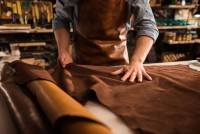Due to a large surface area and fibrillar structure, vulnerable leathers readily absorb water & oil based substances to which they can be frequently exposed. Thankfully, specialised fluorocarbons can be spray or drum applied in order to provide protection to vulnerable footwear.
Fluorocarbon treatments provide protection against the effects of wet weather, melting snow, food or drink stains without changing the natural feel and look of leathers.
The protection imparted by fluorocarbons - whether by drum or spray application - treats largely the surface-layers. Under heavy mechanical load it is possible for both water and oils to penetrate this surface barrier. Under these conditions of stress it is therefore possible to introduce stains. Nevertheless, if these leathers have been treated with fluorocarbons they are much easier to clean than untreated leathers. Application of fluorocarbons to washable leathers enables an "easy care" approach for footwear and apparel.
Typical performances for surface protection of casual and industrial footwear
For casual footwear, there is a discernible increase in demand for improved comfort in terms of longer-lasting coolness and dryness for the wearer. In this respect, leather has a natural advantage over synthetic footwear - as long as the leather is not prevented from breathing by having been finished or heavily waterproofed. This is because all finishes act as a surface barrier to the passage of water vapor, and likewise heavy waterproofing reduces the water vapor permeability.
However, this demand for improved comfort cannot be separated from the consumer expectation that footwear should also have some surface protection. Thankfully, the protective materials from 3M (Scotchgard™ Protector for leather) impart surface protection without any discernible effect on water vapor permeability, they are therefore eminently suitable for inclusion in recipes for making this type of shoe upper.
Fluorocarbons also offer a high level of protection in industrial applications. This is especially important in areas where leather might otherwise be subject to breakdown of the structure, such as contamination by acids or alkali.
Salt stain resistance
Walking in winter time on a snowy street can easily turn into a disaster when a couple of hours later, after drying, a white crust of salt appears, creating an irreversible loss of softness and an unpleasant appearance to the shoes (especially on dark shades). The fluorocarbon barrier protects the leather from salt water, even if the salt can dry out on the leather surface, a vigorous brushing will be enough to get rid of the stain.
Salt stain resistance :
- Treated and non treated shoes are plunged into saturated sodium chloride solution for 1 hour.
- The shoes are air dried and cleaned with a regular shoe brush.
- Treated shoes keep their original quality. Salt stains remain on the non-treated shoe via crystallization inside the leather structures, creating an irreversible loss of softness and an unpleasant appearance to the shoes.
Industrial risks for footwear and gloving Industrial footwear and gloving also require a best in class surface protection. Handling strong acids and alkalis at work means complete and safe protection for the workers. A fluorocarbon treatment with 3M Protective Materials builds an outstanding surface protection against the most concentrated acids and alkalis. Hydrochloric acid even does not alter the leather surface but without any treatment, the leather would dramatically and instantly shrink. Also a boiling saturated solution of sodium hydroxide will only cause a slight burn of the leather surface instead of a complete burn through penetration without a fluorocarbon treatment.
Acid resistance:
a) Spontaneous reaction of hydrochloric acid on non treated leather
b) Demonstration of acid resistance of treated leather
Peace of mind for the customer!
Wearing a suede or double face coat in the rain or sitting on a smooth comfortable nubuck sofa requires trust in the protection of your most valuable goods.
Increasing numbers of companies have understood the necessity of easy maintenance and "easy care" to promote their products at the consumer level. What is better than wonderful apparel, machine-washable with lasting protection against stains?
Nowadays "peace of mind" concepts are becoming more & more important and respected buying factors by the end user.
Application of 3M Protective Materials for leather
1) When applied in the drum at tanneries, the following application levels are recommended. (These levels also qualify for the Scotchgard™ Protector brand).
As a co-application:
After the dyeing process, 3-6% PM-4700 (on shaved weight), 10 min before or after the introduction of the fatliquors.
As an after treatment in the drum:
3-6% PM-4700 (on shaved weight), in a fresh bath, at 35-50°C; pH 3.5-3.7; for 40-60 min.
2) When used as a spray application to the grain or suede surface, the following are typical levels of application:
Aqueous spray application
75-300g PM-4701
925-700g Water
Apply 15 – 5 g/ft2 (co-solvents for wetting - ethylene glycol or methoxypropanol)
Solvent spray application
25 - 50g PM-4800
975-950g solvent or solvent blend (ethers, ketones & esters).
Apply 15 - 5 g/ft2
Keep your leathers looking good longer
The surface protection of treated leathers kept under static conditions actually continues to improve for some months. The effect of wear can however, have the opposite effect and this can be simulated by a simple abrasion test which is based on the use of sandpaper attached to the head of a crockmeter. There is little change in the performance of 3M Protective Materials products by this surface abrasion, whereas products available from other sources show a lowering of performance.
Performance monitoring for the Scotchgard branding procedure includes oil and water repellency before and after such abrasion. This establishes the Scotchgard™ Protector for leather as the best in class surface treatment with durable performances.
New chemistry and favorable environmental profile
The 3M fluorochemicals used in the treatment of leather are based on perfluorobutyl chemistry. When applied, dried or cured onto the leather fibres, the fluorochemical tails orientate themselves away from the substrate imparting to the leather surface a low surface tension, which allows liquids to bead up and repel.
In the 1990´s, it was found that the ultimate breakdown product (PFOS - Perfluorooctanesulfonate) of the perfluorooctanyl (C8F17-) based chemistry, which was used at that time for surface protection, was being found in the environment at very low levels. Although extensive research indicates that no health or environmental effects result from these breakdown products at these very low levels, 3M decided to phase out these products.
After significant R & D work, new leather protectors based on perfluorobutyl chemistry (C4F9-) have been developed. This new technology has a favorable environmental, health and safety profile. With the help of these new building blocks it is possible to produce high molecular weight polymers that remain stable during the useful lifetime of the treated leather. Furthermore, the polymers are developed in such a way that they will contain very low levels of residual monomers that have the potential to degrade further to PFBS (Perfluorobutanesulfonate).
Concerning the ultimate degradation product of this new chemistry, PFBS, test findings provide evidence that this substance is persistent, but it is not considered bioaccumulative or toxic under the U.S. EPA persistent, bioaccumulative, and toxic chemical policy. The acute ecotoxicity data show that PFBS would be classified as an insignificant hazard by the U.S. NIOSH and require no label warning under E.U. regulations.
The necessity of branding for leather
Scotchgard™ Protector for leather is one of the most famous brands applied in the leather industry. The high recognition level and reliability of Scotchgard™ Protector for leather and related performances are determining advantages for business opportunities. Brand differentiation is nowadays an outstanding solution for gaining new market shares.
Scotchgard™ Protector for leather and its dual action which offers stain repellency and stain release is the key solution in combining the appropriate leather treatments to match consumer expectations.
To apply the Scotchgard™ brand to shoes, apparel or furniture, leathers must pass stringent specifications regulated by 3M involving the most rigorous methods for leather surface protection assessment.
Distribution of Scotchgard™ Protector for leather
TFL is the authorized distributor of 3M protective materials for the leather industry. PM-4700 is an aqueous based product for drum application, PM-4701 is an aqueous based product for spray application and PM-4800 is a solvent based formulation for spray application.
Safety Data Sheets
Get the SDS directly from the 3M website.
Contact
For further information concerning Scotchgard™ Leather Protector please contact Michael Donohue.



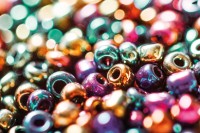

 Main Reaction - The TFL Blog Stories, incidents, tips and facts around the topics leather, chemistry, fashion, sustainability and ecology. Our editorial staff consisting of experienced tanners, scientists, market experts, fashion and communication specialists has sharped their pencils and will supply you with fresh and inspiring content on a regular basis.
Main Reaction - The TFL Blog Stories, incidents, tips and facts around the topics leather, chemistry, fashion, sustainability and ecology. Our editorial staff consisting of experienced tanners, scientists, market experts, fashion and communication specialists has sharped their pencils and will supply you with fresh and inspiring content on a regular basis.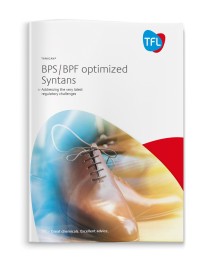
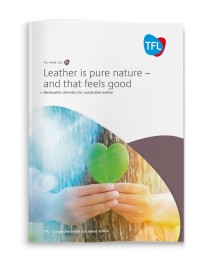
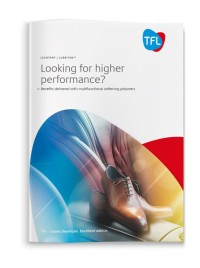 LEVOTAN® / LUBRITANTM - Looking for higher performance? Tanners around the world are facing increasing challenges from their customers, for example, demands for higher performance such as fastness to light and heat resistance, but also lighter weight leather and more recently odour / emissions avoidance.
LEVOTAN® / LUBRITANTM - Looking for higher performance? Tanners around the world are facing increasing challenges from their customers, for example, demands for higher performance such as fastness to light and heat resistance, but also lighter weight leather and more recently odour / emissions avoidance.




